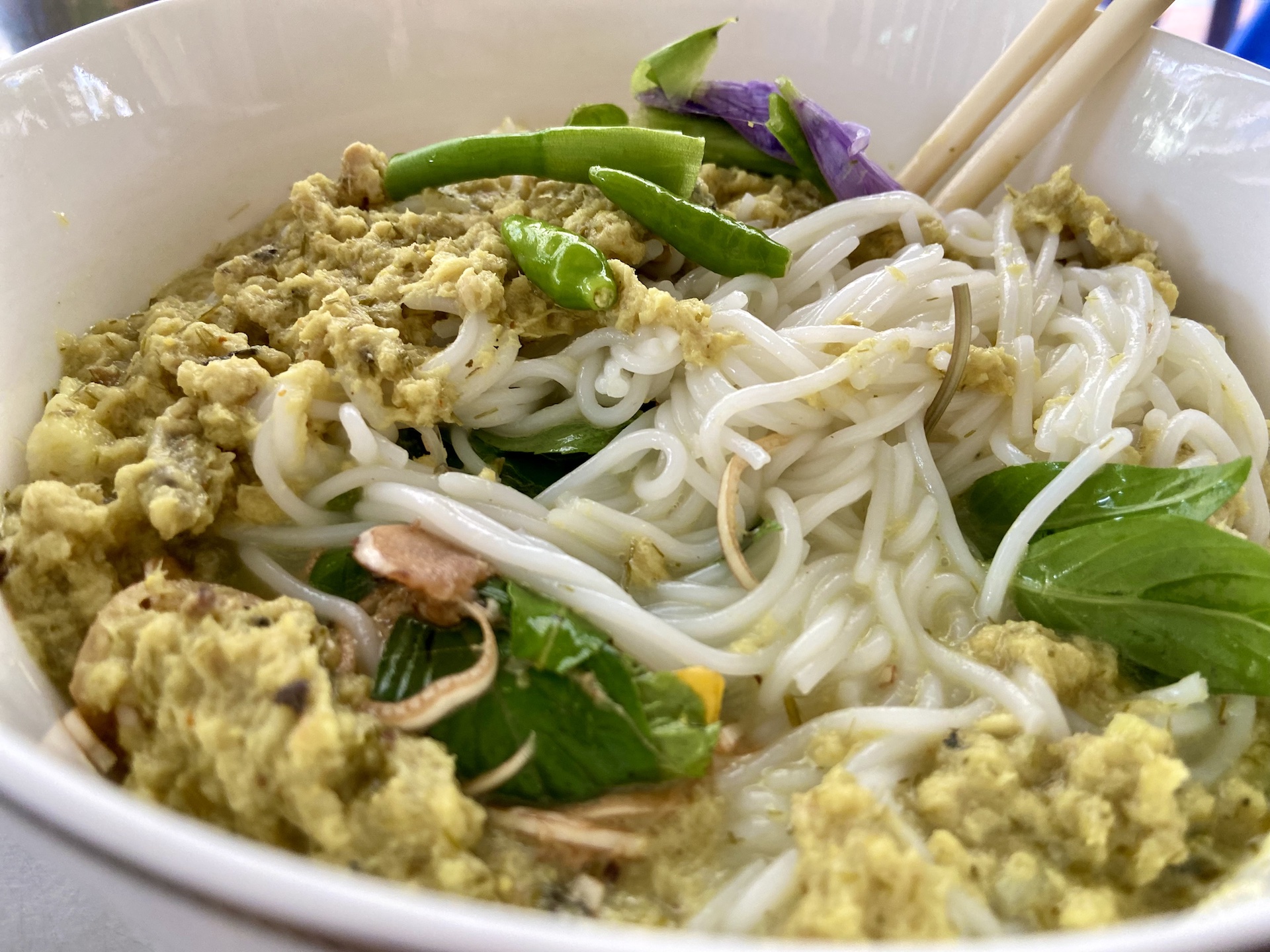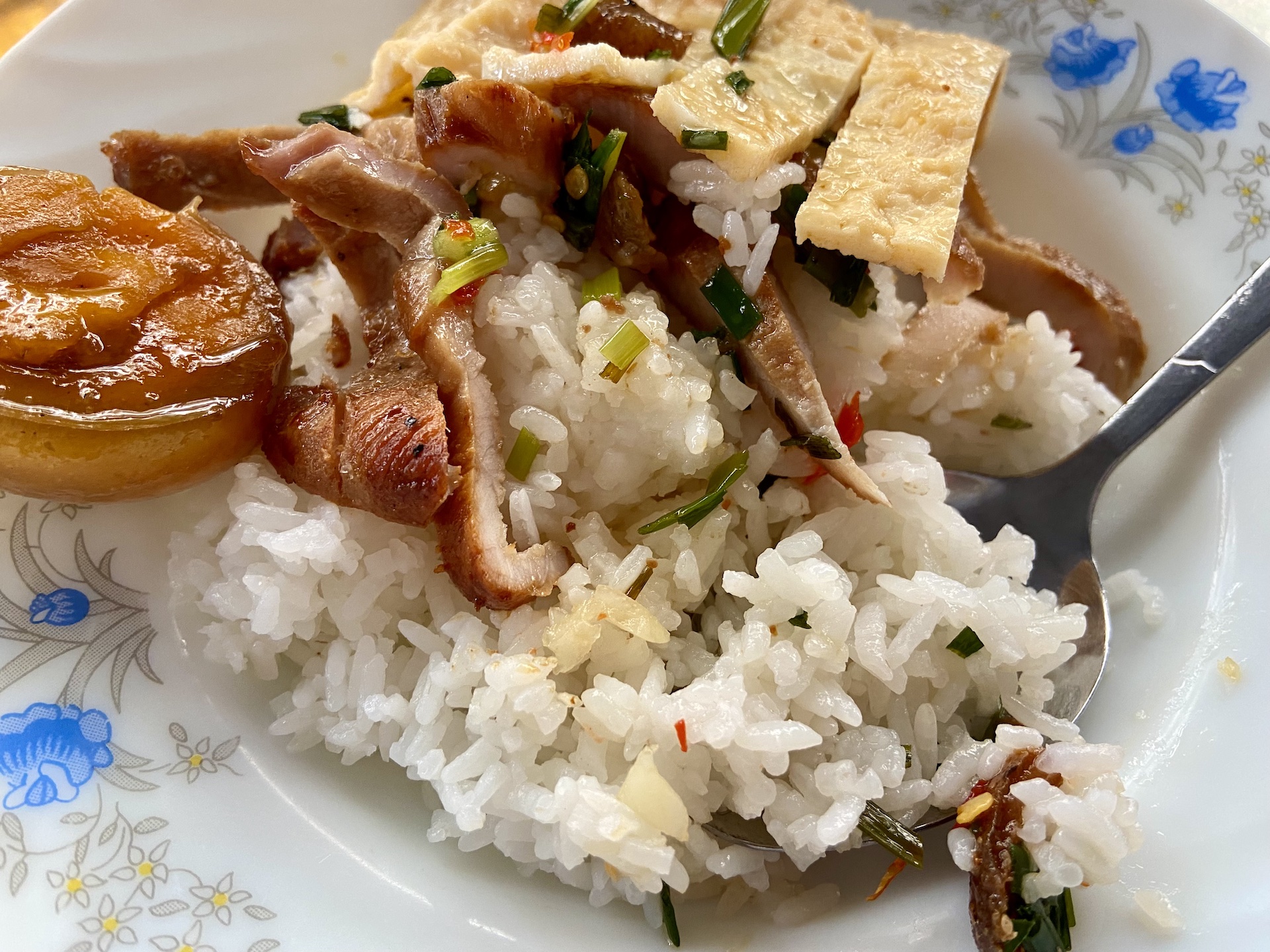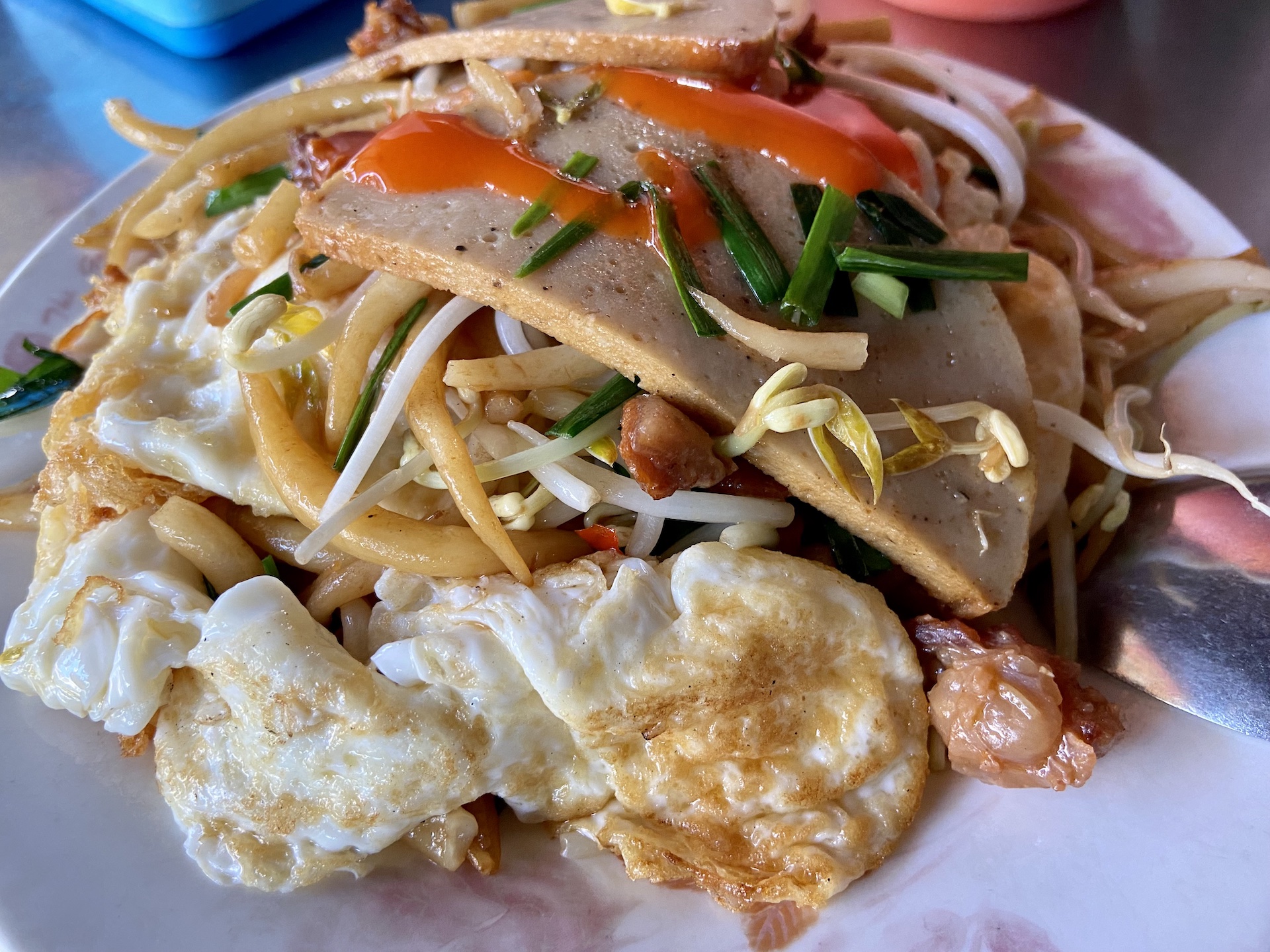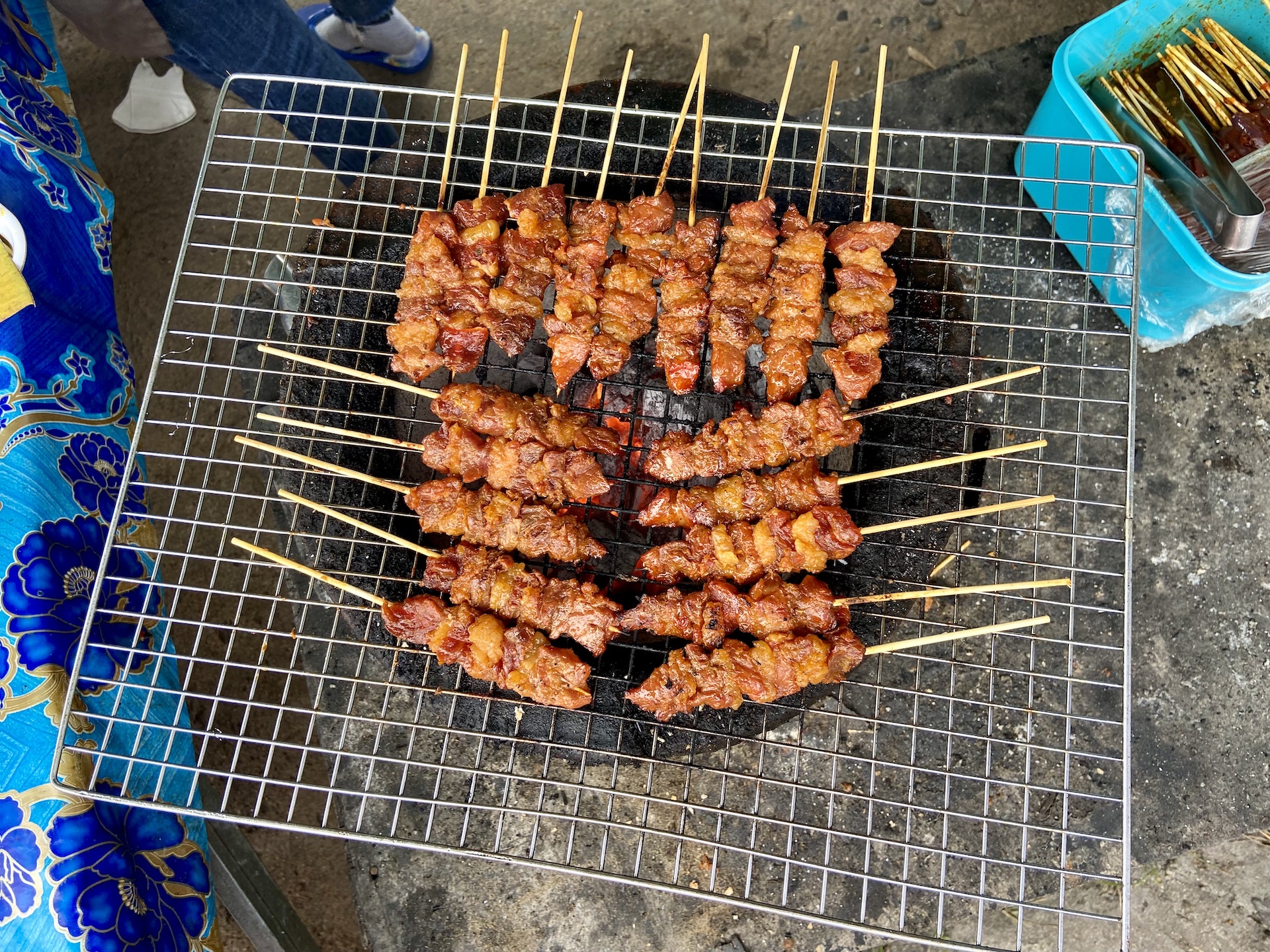Cambodia offers a delightful explosion of flavors, blending Southeast Asian influences with its own unique flair. This is just a starting point for your Cambodian culinary adventure. Get ready to tantalize your taste buds and experience the unique flavors this beautiful country has to offer!
Cambodian food is quite underestimated compared with Thai or Vietnamese food. And it it is way more than Beef Lok Lak and Fish Amok (although the latter is much better than its equivalent, the Thai Hor Mok). The variety of Samlors, Khmer soups, is nearly endless, and then there are grilled dishes and the exotic ones, like snake soup and the fried spiders.
The five essential elements of Khmer cuisine
1. Rice: Rice is the staple food of Cambodia and is a central part of every meal. It is usually steamed and served with various dishes, including curries, stews, and stir-fried dishes.
2. Herbs and Spices: Khmer cuisine is known for its bold and complex flavors, which are achieved through the use of fresh herbs and spices like lemongrass, kaffir lime, galangal, and ginger.
3. Fish Sauce: Fish sauce is a staple condiment in Cambodian cuisine, providing a salty and savory flavor to dishes.
4. Coconut Milk: Coconut milk is used in many traditional Khmer dishes to add a rich and creamy texture to soups and curries.
5. Fresh Vegetables: Fresh vegetables like cucumber, lettuce, and bean sprouts are commonly used in Khmer dishes, providing a crisp and refreshing contrast to the rich and flavorful sauces.
What are the secrets of cooking delicious Khmer food?
Food in Cambodia in general is less spicy and more sweet. Many recipes will require at least a tablespoon of palm sugar (or even more). The spices used are from India and Asia like cardamom and cinnamon. Tumeric is common, ginger and galangal as well.
The classic homemade food is based on what is in the garden and in season. Although thanks to imports from Thailand, China and Vietnam nearly everything is available on the market all year through, local homes still try to get most from the garden. When you [enjoy a meal with locals](https://dinewiththelocals.com/), you may see that they will pick lots of leaves from nearby bushes and trees.
For example the leaves of the tamarind tree. Usually only the sweet-sour fruit is known (and important for the Samlor Kits), the leaves can be used in soups and as a herb in Omelette.
Another ingredient is roasted rice powder. Dry rice is roasted in a pan on open fire, then pounded in a mortar until its a fine powder. It will be used then in Samlor Kor Ko. Most people use the regular rice, but some will roast sticky rice, because it’s more fragrant. Making Samlor Kor Ko is also quite typical for the way many dishes are prepared: You take ginger, turmeric, galangal, lemongrass, garlic and shallots and brown them in a pan for a few minutes. Only then you can pound them in a mortar into a think paste. This paste is also called “krueng” and can be used in many other dishes.
Very important is the Cambodian fish paste. It’s called Prahok and is similar to the Lao Patek and the Thai Pla ra. The basis is crushed fermented fish left in the sun, then its salted and traditionally left in clay jars (but many use plastic containers these days). Prahok can be fried and then used as dip with rice and vegetables or used as an ingredient for soups and stews. Another use is to wrap it in banana leaves and cook it on a fire, covered with stones. As most fish and shrimp based pastes, it has a strong smell and sometimes hotels do not allow consumption of prahok in the room (bus companies may ban it as well).
The secret of fish amok
Amok means steamed coconut with a paste made of galangal, chilli, garlic, lemongrass, Kaffir lime and shallots. It will the be steamed with crushed fish or chicken. Vegetarian can also use Tofu instead. The secret of the Khmer amok are the young leaves of a plant called Noni ([Morinda citrifiola](https://en.wikipedia.org/wiki/Morinda_citrifolia)) or Gnor in Khmer . The leaves are cut in small stripes and added to the mix of paste, coconut and fish. It can be steamed or even cooked in a pot, but the right way is to steam it in baskets made from banana leaves.
[How to cook Khmer Amok](https://cambopedia.com/how-to-cook-khmer-amok/)
Khmer way of cooking meat
If you like street food, than the Khmer BBQs are the best place to try everything grilled. It is common to grill every kind of meat, from pork and beet to squid, frogs, snakes and rats. The latter for example are a well known dish in Battambang, Cambodias second biggest city. Beef is often marinated or covered in a spice mix. One of the most delicious take always are Lemongrass beef skiers. Other meat is usually marinated with chilli and sugar mix.
The other, on many houses more popular way to prepare meat is cha, what means stir fried. Beef Lok Lak is the most famous dish, but also noodles will be cooked first and then mixed with vegetables and sauces to be fried in a pan.
Noodles in the morning
When it comes to noodles, you will clearly see the influence of Chinese immigrants, who came to Cambodia centuries ago. They brought the flat white noodles and the egg noodles for example. One famous noodle soup is Nam ban choke Samlor trey, a soup with coconut and finely chopped fish, usually eaten in the morning. A stereotype for Asian food is the noodle soup, and Cambodia also has it’s own version, Khuy Teav. It is made from pork stock and contains white rice noodles and vegetables as well as beef or pork sliced and meat balls.
The Khmer version is more subtle than the Lao Pho and less intensive than the Vietnamese Pho, while the Thai Kuh Thiau is much more spicy. In Cambodia, the garnish is provided separately, and you can add lemon, bean sprouts, chili paste, sugar and soy sauce as well as fresh herbs to your liking.
The best way to experience the real local food is not the street food, but homemade dishes in local homes. You can book it online with services like [Dine With The Locals](https://dinewiththelocals.com/), doing an excursion to Oudong Mountain or just make some friends and ask them if you can join them for a meal at home.
Contributed by the Dine With The Locals team
What are the 5 best Khmer food?
Cambodia, also known as Kampuchea, is known for its delicious and flavorful cuisine, which is heavily influenced by the flavors of neighboring countries such as Thailand, Vietnam, and Laos. Here are five traditional Cambodian dishes that are considered to be some of the best:
1. Amok: This is a classic Cambodian dish that consists of fish or meat (usually chicken or fish) that is marinated in a mixture of herbs and spices, then wrapped in banana leaves and steamed. It is typically served with steamed rice and can be quite spicy.
2. Lok Lak: A dish that consists of marinated beef, it is stir-fried with onions and peppers, and served with a lime and pepper dipping sauce. It’s a dish that’s easy to find in street vendors, restaurants and on a local home table as well.
3. Fish Amok: Similar to regular amok, but this time is made with fish, it’s usually made with freshwater fish, like Mekong Catfish, which is abundant in Cambodia, this dish is creamy with a good amount of spice and served with rice.
4. Bai Sach Chrouk: This dish is made of grilled pork and rice. It’s a Cambodian breakfast staple and it is usually served with pickled vegetables on the side and a traditional Cambodian dipping sauce called.
5. Nom Banh Chok: This is a traditional Cambodian breakfast dish consisting of rice noodles served in a light curry broth with a variety of toppings such as bean sprouts, herbs, and fish. It’s a light but filling dish and it can be found in street vendors, markets, and restaurants.
These are just a small sampling of the delicious and diverse foods that Cambodia has to offer. In general, Cambodian food tends to be quite spicy, so be prepared for some heat if you order these dishes. Also, please keep in mind that these are traditional dishes, and the recipe and the ingredients used might vary from place to place, even from family to family.
Cambodian food in Phnom Penh: and where to find them
Whether you’re a tourist or an expat, the craving for Khmer food is just normal. You want to taste the Cambodian cuisine, but which restaurants in Phnom Penh that offer something authentic and local experience? There are many restaurants in the Cambodian capital that advertise that they offer Cambodian cuisine.
Romdeng Restaurant
Housed in a French-styled villa, Romdeng Restaurant has some specialty dishes like Fish Amok, Beef Pomelo Salad Fries, Curry Khmer Dishes, Spring Rolls Rice, and Fried Tarantulas. Romdeng is a fine restaurant for family lunch or dinner. This Phnom Penh restaurant is being run by Mith Samlanh, an non-profit organization that help street children. 74 St 174, Phnom Penh, Cambodia
Tone Bassac restaurant
This is an interesting restaurant of many choices. If you want to eat more than just Khmer food, Tonle Bassac is the best restaurant to go. They offer buffet of Khmer, Asian, and Western food. One of the dishes you should not miss is Cambodian noodle with soups. Many of my friends and I also praise the good taste of the variety of Khmer soups. These soups are quite unique with fishes or chicken and local ingredients. One of which is Cambodian curry. Tonle Bassac restaurant on Mao Tse Tung boulevard map.
Khmer Thai restaurant
As in it’s name, this restaurant, near the Olympic Stadium, serves both Khmer and Thai food. Khmer Thai resto has a long menu of Cambodian food you can order. However, comparing with others in it’s class, this place is quite expensive.
Kraya Angkor
I like this small Khmer food restaurant for its delicious dish of Cambodian food served in Cambodian way. You should order a set of vegetables with Kapi, Amok, grilled beef, and Koko soup. Kraya Angkor restaurant is near Beung Keng Kang market and school. It’s on street 63, house 60, in Beung Keng Kang district.
Labaab Restaurant: Asian food in Phnom Penh
At first glance, you may not know that there is a nice restaurant on the second floor of the old building. But the hidden gem is there where you can indulge in a very Khmer setting of eating Cambodian food of Battambang.
Looking for a local restaurant to dine in a beautiful atmosphere? Check out Labaab restaurant on Monivong Boulevard, just opposite to the Canadia Tower. The interior design is so local. If you want to taste the Mekong cuisine, Labaab restaurant is the ideal place to check out. You can order Thai, Vietnamese or Battambang (Khmer) food.
Most customers love Labaab for the fact that:
– the prices are so reasonable.
– the service is fast and good.
– food is a good mix of Khmer and Vietnamese cuisine. Tastes like a home cooked meal.
– nice decoration and convenience for meeting. Relaxing atmosphere with nice scenery.
– the interior decoration and design are just beautiful and the Cambodian cuisine is very innovative.
Labaab Restaurant brings to you Mekong home-cooked cuisine in a Khmer house design setting in the middle of Phnom Penh city center.
Here’s a guide to whet your appetite for some must-try dishes across the country:
Cambodian classics
Fish Amok: Cambodia’s national treasure, this dish features steamed fish in a creamy coconut curry infused with fragrant kroeung paste (a lemongrass, turmeric, and galangal blend) and palm sugar. Traditionally cooked in a banana leaf, it’s a symphony of textures and tastes.
Nom Banh Chok: A refreshing breakfast or light meal, these thin rice noodles are served in a cool fish curry broth with chopped vegetables, herbs, and sometimes protein like shrimp or pork.

Khmer Curry: Available in a vibrant array of colors (red, green, yellow), each curry boasts a distinct flavor profile. Red curries lean towards sweetness, while green curries pack a spicy punch, and yellow curries offer a mellower taste.
Beef Lok Lak: This stir-fried dish is a crowd-pleaser. Marinated beef cubes are cooked with oyster sauce, lemongrass, and vegetables, typically served with steamed rice and a sunny-side-up egg on top.

Samlor kako: A hearty and comforting soup, perfect for a light meal or a rainy day. It’s made with vegetables, lemongrass, kaffir lime leaves, fish paste, and sometimes includes pork, beef, or shrimp for added protein.
Street food delights

Cambodian street food is a vibrant scene, offering an explosion of flavors and aromas at affordable prices. Don’t miss these gems:
Cambodia’s most popular street food: Lort Chha
This stir-fried noodle dish is easy to find when you’re Phnom Penh, Cambodia. It’s a common street food for breakfast, lunch, afternoon snack, and dinner.
More or less it’s a combination of Cambodian-Chinese way of frying of rice pin noodles (not instant noodles). It’s healthier than other street or junk food.
Cambodian-Chinese pan-fried noodles: lort cha
The authenic lort cha is the most popular street food for Cambodians. Reasonable prices and delicious taste make Lort cha into a daily snack, easy to grab because there are vendors selling almost everywhere in Phnom Penh.
Young and old alike buy fried stir-fried noodle dish sold by cart at a price between $1 per box. Lort cha (or lort Chha) is often served with vegetables, beef or pork, a squirt of chilli sauce, and fried duck eggs on top. In this case, you can use other meats or vegetables you like to fry your own lot chha.
These are probably some reasons that make this stir-fried noodle dish the most favorite among Cambodians when they are hungry. It 2022, lort cha makes it in the list of the 50 most popular street food in Asia, published by global media CNN.
Lort or lot is the Khmer language for the short rice-flour noodles. Cha or chha means to stir-fry. This Cambodian-Chinese dish, originating in Cambodia’s Chinese-Khmer communities.
How to cook Lort cha: the recopies you need 1/2 kg lote rice noodle a handful of bean sprout a handful of green onion 2 spoon of oyster sauce 5 spoon cooking oil chili sauce one egg
How to preparation Heat the oil in a pan on high. Add oyster sauce. Stir then add shrimp and stir well. Add Lote, stir fast until mix, adjust your taste. Add bean sprout and green onion, stir fast, then scoop out. Fry one egg-over easy style and place on top when serve. Best to go with sweet sour chili sauce.

Num Pang: Literally translating to “bread,” these are baguettes filled with an assortment of delicious ingredients like meats, pickled vegetables, fresh herbs, and pate.

Kuy Teav: This versatile noodle soup is a staple throughout the day. The broth can be flavored with pork, beef, fish, or chicken and comes with various toppings like bean sprouts, herbs, and fried shallots.

Skewers: Grilled meats and vegetables on skewers are a popular street food option, perfect for a quick and flavorful snack.
Sticky Rice with Mango: A sweet treat enjoyed during mango season (roughly April to June). Sticky rice is steamed in coconut milk and served with slices of ripe mango, offering a delightful contrast of textures and flavors.
Regional specialties
Kampot Pepper Crab: A specialty in the coastal town of Kampot, fresh crabs are stir-fried with the region’s famous black peppercorns, creating a dish with a unique peppery kick.
Beyond the savory
Cambodian desserts tend to be sweet and sticky, often featuring rice, coconut milk, and palm sugar. Popular options include sticky rice with mango (mentioned above) and mee goang (sweet stir-fried noodles).
Food you should taste when in Phnom Penh
Phnom Penh is a haven for foodies, offering a delicious mix of Cambodian cuisine, international fare, and mouthwatering street food. Here’s a guide to tantalize your taste buds:
Must-try Cambodian dishes
Bai Sach Chrouk: A simple yet satisfying breakfast option. Grilled pork belly is served over steamed broken rice with pickled vegetables and a dipping sauce for a refreshing touch.
Exploring international cuisine:
Phnom Penh offers a surprising variety of international restaurants, catering to various tastes and budgets. Here are some options:
French: Cambodia’s colonial past means you can find delicious French restaurants serving classic dishes.
Indian: For a taste of Indian curries and flavors, there are several Indian restaurants in Phnom Penh.
Thai: Given the geographical proximity, Thai restaurants are plentiful, offering all your favorite curries and noodle dishes.
Vegetarian/Vegan: The growing vegetarian and vegan scene caters to those seeking meat-free options.
Tips for Phnom Penh foodies
Don’t be afraid to try street food: It’s a delicious and affordable way to experience Cambodian cuisine. Just stick to well-patronized stalls and use your best judgment.
Carry cash: Many street vendors won’t accept credit cards.
Embrace the spice: Cambodian cuisine can be spicy. Ask before you order if you have a low spice tolerance.
Sample local fruits: Cambodia boasts a variety of exotic fruits like durian, rambutan, and mangosteen.
Tips for adventurous eaters
Embrace the spice: Cambodian cuisine can be spicy, but most restaurants will adjust the spice level upon request.
Don’t be afraid to try street food: It’s a delicious and affordable way to experience Cambodian cuisine. Just stick to well-patronized stalls and use your best judgment.
Carry cash: Many street vendors won’t accept credit cards.
Sample local fruits: Cambodia boasts a variety of exotic fruits like durian, rambutan, and mangosteen.
Salted, dried fish: a Cambodian staple
Salted, dried fish is a staple food in Cambodia. It is made by salting and drying fish, which helps to preserve it and make it last longer. Salted, dried fish is a versatile ingredient that can be used in a variety of dishes, both savory and sweet.
History of salted, dried fish in Cambodia
Salted, dried fish has been a part of the Cambodian diet for centuries. It is believed to have originated in the Mekong Delta, where fish is abundant. Salted, dried fish was an important source of protein for the Khmer people, especially during times of war and famine.
How salted, dried fish is made
Salted, dried fish is made by first cleaning the fish. The fish is then salted, either by hand or by machine. The amount of salt used depends on the type of fish and the desired flavor. The fish is then dried in the sun or in a dehydrator.
Types of salted, dried fish
There are many different types of salted, dried fish in Cambodia. Some of the most common types include:
Trey chaa: This is a type of salted, dried catfish. It is a popular ingredient in Khmer cuisine. Trey sneng: This is a type of salted, dried snakehead fish. It is a popular ingredient in Khmer soups and stews. Trey slok: This is a type of salted, dried carp. It is a popular ingredient in Khmer curry dishes.
Health benefits of salted, dried fish
Salted, dried fish is a good source of protein, omega-3 fatty acids, and vitamins. It is also low in calories and fat. Salted, dried fish can help to improve heart health, reduce the risk of cancer, and boost the immune system.
How to cook with salted, dried fish
Salted, dried fish can be used in a variety of dishes, both savory and sweet. Some of the most popular ways to cook with salted, dried fish include:
Fry it: Salted, dried fish can be fried until crispy and then served as a snack or appetizer. Simmer it: Salted, dried fish can be simmered in soups and stews to add flavor and protein. Grill it: Salted, dried fish can be grilled and served with rice or vegetables. Make it into a salad: Salted, dried fish can be chopped and added to salads for a protein boost. Use it in a curry: Salted, dried fish can be used in curries to add flavor and texture.
Where to buy salted, dried fish
Salted, dried fish is available in most Asian grocery stores. It can also be found online.
Salted, dried fish is a delicious and nutritious food that is a staple of the Cambodian diet. It is a versatile ingredient that can be used in a variety of dishes. If you are looking for a healthy and flavorful way to add protein to your diet, I encourage you to try salted, dried fish.
Leave a Reply
You must be logged in to post a comment.